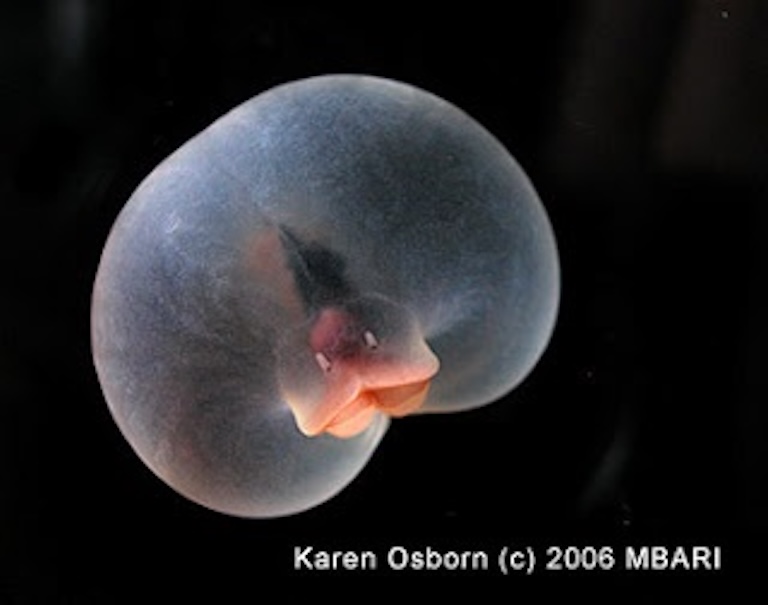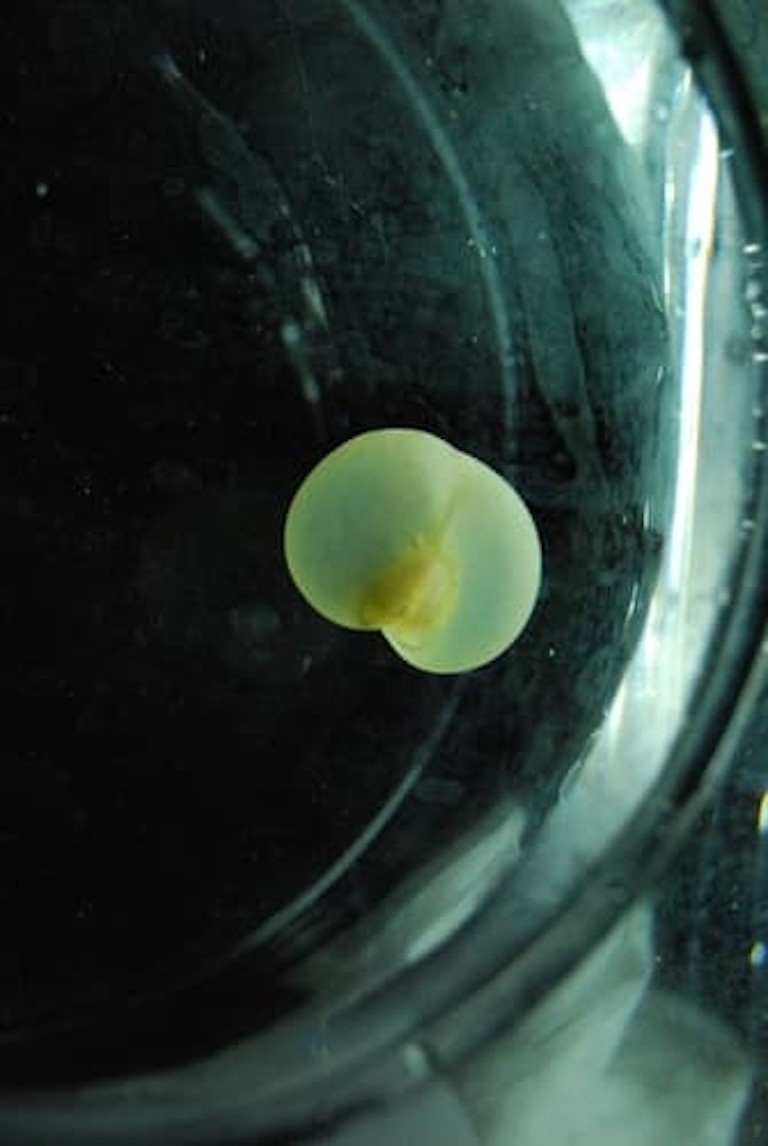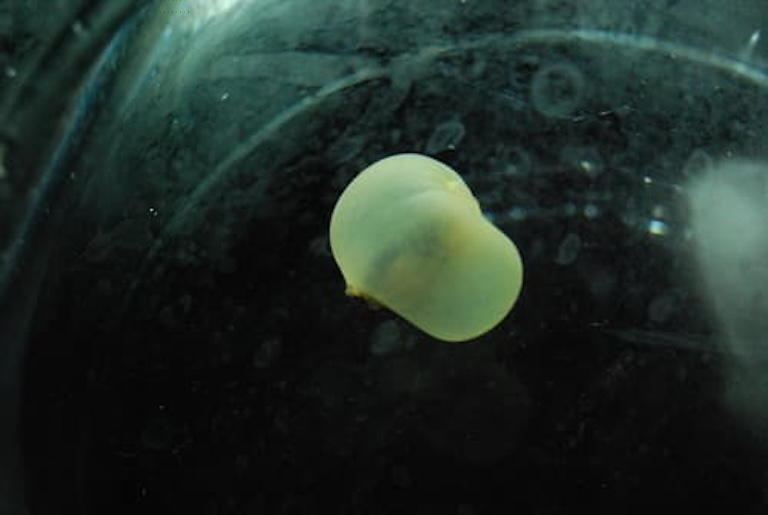Pigbutt Worm Profile
In the midwater depths of the ocean, around a kilometre down, there’s an animal so inappropriate you wonder how it evaded Google’s SafeSearch.
Usually, referring to something as a pig’s butt could be considered an insult. But in the case of Chaetopterus pugaporcinus, this is the polite thing to name it.
Much in the same way a Christmas dinner can become awkward when the dog starts licking his balls, the pigbutt worm is a great reminder of how we as a prudish society would rather change the subject when it comes to the topic of genitals.

Pigbutt Worm Facts Overview
| Habitat: | Midwater, from 800m to 1200m |
| Location: | California (likely elsewhere) |
| Lifespan: | Unknown |
| Size: | 2.1 cm (0.8 inch) |
| Weight: | Unknown |
| Colour: | Pink-ish |
| Diet: | Marine snow |
| Predators: | Unknown |
| Top Speed: | Planktonic |
| No. of Species: | 1 |
| Conservation Status: | Unknown |
This worm looks less like a pig’s butt and more like it should come with batteries included. The authors of the first paper describing this animal called it, “An unusual pelagic polychaete”, and this is spot on: it’s an inflatable ocean worm that ejaculates mucous to catch snow.
Interesting Pigbutt Worm Facts
1. They’re bristle worms
It should be noted that the pig-butt worm is a very different animal than the pig butt-worm, which is something you can get from eating undercooked pork. The latter is a nematode, whereas this one is an annelid, or segmented worm (like the ones you find in your compost pile).
More specifically, they’re polychaetes, marine annelids, named for their chaetae, or hairs, which give them the nickname bristle worms. This class of annelid is hugely diverse and includes animals like the terrifying Bobbit worm all the way to the beautiful, filter-feeding feather duster worms.
So, pigbutts are segmented, like other bristle worms, only within this one, the middle segments are highly inflatable. Their bodies are barrel-shaped, with a ciliated, or hairy groove down the middle, giving them the recognisable crack.
This group of worms are usually fixed to the ground in tubes or buried in the seafloor sediment but have free-floating larval stages first. But the pigbutt seems to have characteristics of both adult and larval stages. 1

2. They don’t have a tail
The first error to spot in the naming of this animal is the distinctive lack of a curly protrusion commonly found at the back end of pigs.
The glaringly vulva-like elliptical grooves are there, but as far as butts go, this one resembles more of an upright walking ape than a swollen porcine. These grooves are compressed segments, collapsed in favour of its inflatable middle, which expands like a puffer fish when the animal is disturbed.
Other nicknames include the “Pwet worm”, which is Tagalog for “butt worm” and the “Floating Buttocks” (a risky image search that does lead you to a story about a baffled Scotsman), which is far more accurate, as these little worms aren’t able to swim on their own. 2
3. Face down, ass up
Not a lot is known about this species, with only 12 specimens taken and it has only been seen in the wild around the research missions in California.
It’s commonly found between 800 and 1200 meters and appears to float there, neutrally buoyant, with its mouth end pointing downwards. They don’t appear to be able to swim at all and are therefore planktonic in nature.
It’s thought they rely on filter-feeding to survive, which relies on another very useful adaptation. 3
4. They produce their own lube
If you forget what it looks like for a moment, you may remember that this is indeed a worm and not a butt. That makes it a little safer to imagine the mucous that it ejaculates from its crack.
Pigbutt worms are midwater mucous feeders, and the main groove along their body releases handy snot-like goo that radiates from its body like a casted net.
This net is a web for catching organic matter that sinks to the ocean floor from the chaotic and violent world above.

5. Marine snow
This isn’t an unusual strategy, as it happens. Marine snow is a huge source of food for innumerable animals in the ocean, and their role in the ecosystem extends far beyond their local communities.
Animals who feed on all of this dust are serving the climate of the entire planet by collecting and sequestering carbon.
6. These are some big butts
It’s still a bit of a mystery what, exactly, the pigbutt worm is. For a polychaete adult to be floating about in the water column is unusual, though for their larvae it isn’t.
But polychaete larvae are typically tiny and have many more segments in their form than this one appears to. The largest known example is half the size of this bulbous booty, and the next-biggest example from the genus has a tenth of the junk this trunk is carrying.
So, it’s unusual for a larva, but if it turns out to be an adult, it will be equally strange. For one thing, despite its appearance, this worm has not been found to have sex organs.
7. They glow in the dark
By now you might be thinking that this worm couldn’t get any more like a novelty silicone masturbatory aid, but the presence of bioluminescence suggests more to come. And the best part is, the glowing occurs when the worm is physically stimulated.
Upon agitation, this glow-in-the-dark inflatable rear end releases a pulse of blue light for up to six seconds. It will also eject green sparkles into its mucous cloud.
Pigbutt Worm Fact-File Summary
Scientific Classification
| Kingdom: | Animalia |
| Phylum: | Annelida |
| Class: | Polychaeta |
| Order: | Spionida |
| Family: | Chaetopteridae |
| Genus | Chaetopterus |
| Species: | pugaporcinus |
Fact Sources & References
- “Pigbutt worm”, Monterey Bay Aquarium Research Institute.
- Karen J. Osborn (2007), “Description and Relationships of Chaetopterus pugaporcinus, an Unusual Pelagic Polychaete (Annelida, Chaetopteridae)”, The Biological Bulletin.
- MBARI (Monterey Bay Aquarium Research Institute)(2024), “This curious critter is a worm like no other: The pigbutt worm”, YouTube.
